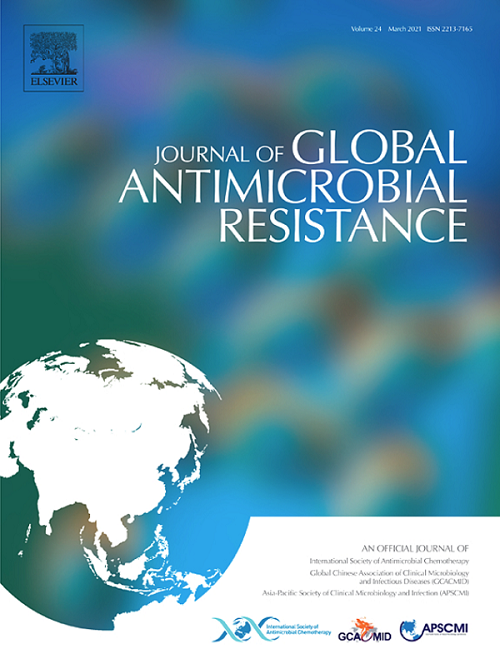Antimicrobial resistance in Campylobacter spp. focussing on C. jejuni and C. coli – A narrative review
IF 3.2
3区 医学
Q2 INFECTIOUS DISEASES
引用次数: 0
Abstract
Objectives
Campylobacter species represent one of the leading causes of human foodborne infections, including gastroenteritis and bloody diarrhoea. Overuse of antibiotics in veterinary, agriculture, and humans has led to an increase in multidrug antimicrobial resistance (AMR). Fluoroquinolones and macrolides resistant Campylobacters are WHO and CDC priority pathogens, with fluoroquinolone resistance doubling in the past 20 years, complicating treatment.
Methods
Published studies relating to AMR and associated molecular mechanisms in both Campylobacter jejuni (C. jejuni) and C. coli from animals, humans and environment (1981–2024), were retrieved from PubMed and Google Scholar using relevant keywords. In addition, genomic analyses of publicly available C. jejuni and C. coli genomes along with multilocus sequence typing results from the PubMLST database were used to analyse these AMR determinants and their phylogenomic relationships. Review articles were excluded from the analyses.
Results
A total of 429 research papers were reviewed to get insights into multidrug resistance in C. jejuni and C. coli. Fluroquinolone resistance has been predominantly associated with international travel. The gyrA subunits were associated with ecological niches and overall, it is suggestive that C. coli might be the donor. A positive synergism was observed between cmeA gene expression and quinolone resistance. Additionally, the results speculated the possibility of horizontal gene transfers in chromosomal resistance clusters between C. coli and C. jejuni.
Conclusions
This review indicated significant concern of multidrug resistance in C. jejuni and C. coli. This requires continent-wide surveillance and research for standard practices to achieve effective antimicrobial stewardship.
弯曲杆菌耐药的研究进展——以空肠弯曲杆菌和大肠弯曲杆菌为重点。
目的:弯曲杆菌是人类食源性感染的主要原因之一,包括肠胃炎和血性腹泻。在兽医、农业和人类中过度使用抗生素已导致多药抗微生物药物耐药性(AMR)增加。氟喹诺酮类药物和大环内酯类药物耐药弯曲杆菌是世卫组织和美国疾病控制与预防中心重点关注的病原体,在过去20年中,氟喹诺酮类药物耐药性翻了一番,使治疗复杂化。方法:使用相关关键词检索PubMed和谷歌Scholar网站上发表的关于空肠弯曲杆菌和大肠杆菌AMR及其相关分子机制的研究,这些研究来自动物、人类和环境(1981 - 2024)。此外,利用公开的空肠梭菌和大肠杆菌基因组基因组分析以及PubMLST数据库的多位点序列分型结果,分析了这些AMR决定因素及其系统基因组关系。综述性文章被排除在分析之外。结果:共回顾了429篇研究论文,了解了空肠梭菌和大肠杆菌的多药耐药情况。氟喹诺酮类药物耐药性主要与国际旅行有关。gyrA亚基与生态位相关,总体上提示大肠杆菌可能是供体。cmeA基因表达与喹诺酮类药物耐药性之间存在正协同作用。此外,研究结果推测了大肠杆菌和空肠杆菌在染色体抗性簇中水平基因转移的可能性。结论:本文综述了大肠杆菌和空肠梭菌的多药耐药问题。这就需要在全大陆范围内进行监测和研究标准做法,以实现有效的抗微生物药物管理。
本文章由计算机程序翻译,如有差异,请以英文原文为准。
求助全文
约1分钟内获得全文
求助全文
来源期刊

Journal of global antimicrobial resistance
INFECTIOUS DISEASES-PHARMACOLOGY & PHARMACY
CiteScore
8.70
自引率
2.20%
发文量
285
审稿时长
34 weeks
期刊介绍:
The Journal of Global Antimicrobial Resistance (JGAR) is a quarterly online journal run by an international Editorial Board that focuses on the global spread of antibiotic-resistant microbes.
JGAR is a dedicated journal for all professionals working in research, health care, the environment and animal infection control, aiming to track the resistance threat worldwide and provides a single voice devoted to antimicrobial resistance (AMR).
Featuring peer-reviewed and up to date research articles, reviews, short notes and hot topics JGAR covers the key topics related to antibacterial, antiviral, antifungal and antiparasitic resistance.
 求助内容:
求助内容: 应助结果提醒方式:
应助结果提醒方式:


